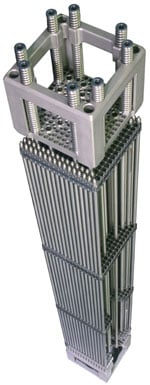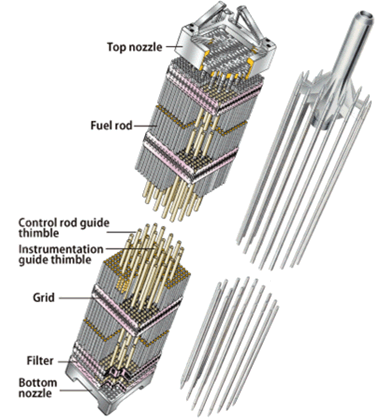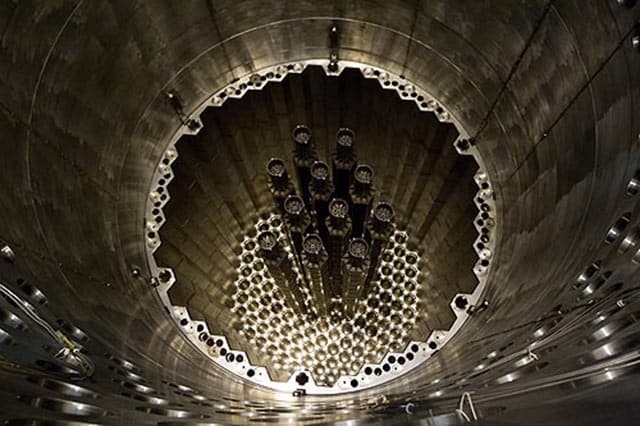
Source: www.kernbrennstoff.de
The core is located inside a reactor pressure vessel and is carried by a core support barrel. A bottom plate of the support barrel is called a lower core plate. This structure consists of N holes for fixing fuel assemblies (N is the number of fuel assemblies in a specific reactor – e.g.,, 157 for AP1000).
There is a neutron reflector (core baffle or heavy reflector) around the core (around peripheral fuel assemblies), usually formed of stainless rings surrounding the nuclear fuel assemblies.
The top of the nuclear core is defined by an upper guide structure assembly. This assembly is made of stainless steel and has many purposes. The upper guide structure assembly exerts an axial force on fuel assemblies (through springs in the fuel assembly), thus defining the fuel assembly’s exact position in the core. The upper guide structure assembly also guides and protects control rod assemblies and in-core instrumentation.
Components of a nuclear reactor core
The key components common to most PWR types of nuclear reactor cores are:
-

The nuclear fuel assembly with the rod cluster control assembly.
Source: www.world-nuclear.orgNuclear fuel. Nuclear fuel is composed of nuclear fuel assemblies located in exact positions in the reactor.
- Neutron moderator. The moderator slows down neutrons from fission to thermal energies.
- Control rods. Control rods are rods, or tubes containing a neutron absorbing material such as boron, hafnium, cadmium, etc., used to control the power of a nuclear reactor.
- Neutron Reflector. The neutron reflector (core baffle) surrounds the core. The reflector reduces the non-uniformity of the power distribution in the peripheral fuel assemblies and reduces a coolant flow bypass of the core.
- Burnable neutron poison. Burnable poisons/absorbers are primarily used to control large amounts of excess fuel reactivity and reduce a concentration of boric acid at the beginning of the fuel cycle.
- Neutron source. Neutron sources increase a neutron flux during the subcritical state.
- In-core instrumentation. The in-core instrumentation system measures neutron flux distribution and temperature in the reactor core. This helps determine the safety margins of the reactor.

Source: http://prinfo.bg/language/bg/uploads/files/pressreleaseindex__0/press_release_1dcda6c54d72ddd734d081fd7d08ebe9.jpg; used with permission of АО ОКБ “ГИДРОПРЕСС”